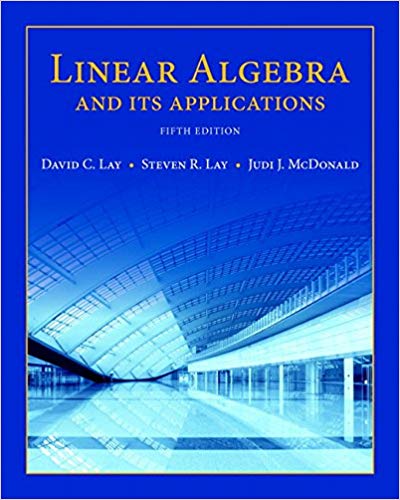
Linear Algebra and Its Applications, 5th Edition
Authors: David C. Lay, Steven R. Lay, Judi J. McDonald
ISBN-13: 978-0321982384
We have solutions for your book!
See our solution for Question 37E from Chapter 4.4 from Lay's Linear Algebra and Its Applications, 5th Edition.
Problem 37E
Chapter:
Problem:
[M] Exercises 37 and 38 concern the crystal lattice for titanium, which has the hexagonal structure shown on the left in the accompanying figure. The vectors form a basis for the unit cell shown on the right. The numbers here are In alloys of titanium, some additional atoms may be in the unit cell at the octahedral and tetrahedral sites (so named because of the geometric objects formed by atoms at these locations). One of the octahedral sites is relative to the lattice basis. Determine the coordinates of this site relative to the standard basis of .
Step-by-Step Solution
Given Information
The basis for the unit cell is given by: \[ B = \left\{ \left[ \begin{array} { c } { 2.6 } \\ { - 1.5 } \\ { 0 } \end{array} \right] , \left[ \begin{array} { l } { 0 } \\ { 3 } \\ { 0 } \end{array} \right] , \left[ \begin{array} { c } { 0 } \\ { 0 } \\ { 4.8 } \end{array} \right] \right\} \] We have to find the coordinates of the octahedral site $[ \mathbf { x } ] _ { B } = \left( \dfrac { 1 } { 2 } , \dfrac { 1 } { 4 } , \dfrac { 1 } { 6 } \right) ^ { T }$ relative to standard basis of $R^3$.
Step-1:
The change of coordinate matrix from B to standard basis in $R^3$ is: \[ P _ { B } = \left[ \begin{array} { c c c } { 2.6 } & { 0 } & { 0 } \\ { - 1.5 } & { 3 } & { 0 } \\ { 0 } & { 0 } & { 4.8 } \end{array} \right] \]
Step-2:
The required coordinate vector is obtained by the product of matrices $[ \mathrm { x } ] _ { B }$ and $[ P ] _ { B }$. \[ \begin{aligned} \mathbf { x } & = P _ { B } [ \mathbf { x } ] _ { B } \\ & = \left[ \begin{array} { c c c } { 2.6 } & { 0 } & { 0 } \\ { - 1.5 } & { 3 } & { 0 } \\ { 0 } & { 0 } & { 4.8 } \end{array} \right] \left[ \begin{array} { c } { \dfrac { 1 } { 2 } } \\ { \dfrac { 1 } { 4 } } \\ { \dfrac { 1 } { 6 } } \end{array} \right] \end{aligned} \]
Step-3:
Use MATLAB to find the product of matrices:
>> A=[2.6 0 0 ; - 1.5 3 0; 0 0 4.8]; >> B=[1/2 1/4 1/6]; >>M = A*B; \[M = \left[ {\begin{array}{*{20}{c}} {1.3}\\ 0\\ {0.8} \end{array}} \right]\] Therefore, the coordinates of $x$ relative to the standard basis is
\[ \mathbf { x } = \left[ \begin{array} { c } { 1.3 } \\ { 0 } \\ { 0.8 } \end{array} \right] \]
The basis for the unit cell is given by: \[ B = \left\{ \left[ \begin{array} { c } { 2.6 } \\ { - 1.5 } \\ { 0 } \end{array} \right] , \left[ \begin{array} { l } { 0 } \\ { 3 } \\ { 0 } \end{array} \right] , \left[ \begin{array} { c } { 0 } \\ { 0 } \\ { 4.8 } \end{array} \right] \right\} \] We have to find the coordinates of the octahedral site $[ \mathbf { x } ] _ { B } = \left( \dfrac { 1 } { 2 } , \dfrac { 1 } { 4 } , \dfrac { 1 } { 6 } \right) ^ { T }$ relative to standard basis of $R^3$.
Step-1:
The change of coordinate matrix from B to standard basis in $R^3$ is: \[ P _ { B } = \left[ \begin{array} { c c c } { 2.6 } & { 0 } & { 0 } \\ { - 1.5 } & { 3 } & { 0 } \\ { 0 } & { 0 } & { 4.8 } \end{array} \right] \]
Step-2:
The required coordinate vector is obtained by the product of matrices $[ \mathrm { x } ] _ { B }$ and $[ P ] _ { B }$. \[ \begin{aligned} \mathbf { x } & = P _ { B } [ \mathbf { x } ] _ { B } \\ & = \left[ \begin{array} { c c c } { 2.6 } & { 0 } & { 0 } \\ { - 1.5 } & { 3 } & { 0 } \\ { 0 } & { 0 } & { 4.8 } \end{array} \right] \left[ \begin{array} { c } { \dfrac { 1 } { 2 } } \\ { \dfrac { 1 } { 4 } } \\ { \dfrac { 1 } { 6 } } \end{array} \right] \end{aligned} \]
Step-3:
Use MATLAB to find the product of matrices:
>> A=[2.6 0 0 ; - 1.5 3 0; 0 0 4.8]; >> B=[1/2 1/4 1/6]; >>M = A*B; \[M = \left[ {\begin{array}{*{20}{c}} {1.3}\\ 0\\ {0.8} \end{array}} \right]\] Therefore, the coordinates of $x$ relative to the standard basis is
\[ \mathbf { x } = \left[ \begin{array} { c } { 1.3 } \\ { 0 } \\ { 0.8 } \end{array} \right] \]